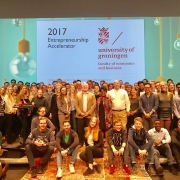Young Entrepreneurs: The Glue that Will Keep Us Together
In many ways, we are living in an epoch of incredulity—the best of times and the worst of times.
While current global debates are focusing on the latter half of this equation, what I just experienced in the Netherlands, with young entrepreneurs during Global Entrepreneurship Week, reminded me of the good, the hopeful, and what brings us together instead of that which is dividing us.
Young entrepreneurs are “seekers.” As such, their eyes, eyes, and minds are wide open. With all they take in, they are analyzing it, looking for opportunities to adapt it and to better it…and in a word, to “disrupt” it. They are seeking to cause disruptions that will improve a person, place, or thing…or process, system, a thought, and even how we actually see things in real and virtual spaces. Not happy to acquiesce in the status quo, they are applying themselves to figuring out how to make things better; not just for themselves, but on a scale that could impact all of us on the planet.
These are the times once again of da Vinci, of Galileo, of Copernicus who had seemingly limitless opportunity to name, it, call it, define it, clarify it, and to make “it” part of our consciousness, perceptions, and way of seeing and doing things.
The young entrepreneurial “seekers” in today’s world are competing with each other and there’s an urgency of now (less someone beat them to the punch in “calling it”). They don’t know each other, nor where the others are located, nor do they know what each other is doing exactly… but they know something big is happening out there. Over the horizon is virtual reality, bigger and better drones, and a growing set of needs in health care, the environment, the military, and of course among those with a desire for consumer products to help them look ageless, sexy, thin, and have better hair!
Somewhere in America, or in China, India, Germany…there are “other” young entrepreneurs on a mission of “disruption” to meets these demands. How are they doing it, who is helping them do it, what is the role of the government, what kinds of accelerators and incubators are they using; how much venture capital are they getting…?
In other words, “what is their secret sauce?”
While no one knows the answer to the question, there is prima facie evidence that in the “new” world, the secret sauce must entail “design thinking.” After all, would Apple be thriving without it; would IKEA, Alibaba, or the many other major disruptors in the world?
So what is “design thinking?”
In a nutshell, it’s a “way of thinking” used to consider issues in order to resolve them.
It uses the designer’s sensibility and methods to match people’s needs with what is technologically feasible and what a viable business strategy can convert into customer value and market opportunity. (Of course, the trick here, is that the line of what’s technologically possible keeps moving, and is moving exponentially fast).
It’s important to note that compared to the scientific method, which begins by stating a hypothesis, design thinking differs by including consideration of the emotional content of the situation. Furthermore, while feedback in the scientific method is obtained by collecting observational evidence with respect to observable/measurable facts, in design thinking, feedback also considers the consumer’s emotional state regarding the problem and in discovering and developing solutions.
Basically, design thinking identifies and investigates both known and ambiguous aspects of the current situation in an effort to discover parameters and alternative solution sets which may lead to one or more satisfactory goals allowing for redefinition of the initial problem, in a process of co-evolution of problem and solution. Essentially, there are five key ingredients in design thinking:
1. Empathizing: Understanding the human needs involved.
2. Defining: Re-framing & defining the problem in human-centric ways.
3. Ideating: Creating many ideas in ideation sessions.
4. Prototyping: Adopting a hands-on approach in prototyping.
5. Testing: Developing a prototype/solution to the problem.
Notwithstanding these five golden rules, the true “secret sauce” lies within the individual…in his/her drive and fortitude; ability to focus and concentrate; willingness to learn and to experiment; and ultimately, in order to succeed, in his/her commitment to excellence.
From what I have seen among young entrepreneurs around the world, they are up for the challenge, in the ring, and making it happen for all of us.
Sharon T. Freeman, Ph.D., President & CEO, Gems of Wisdom Consulting, Inc. (www.gemsofwisdomconsulting.com)



